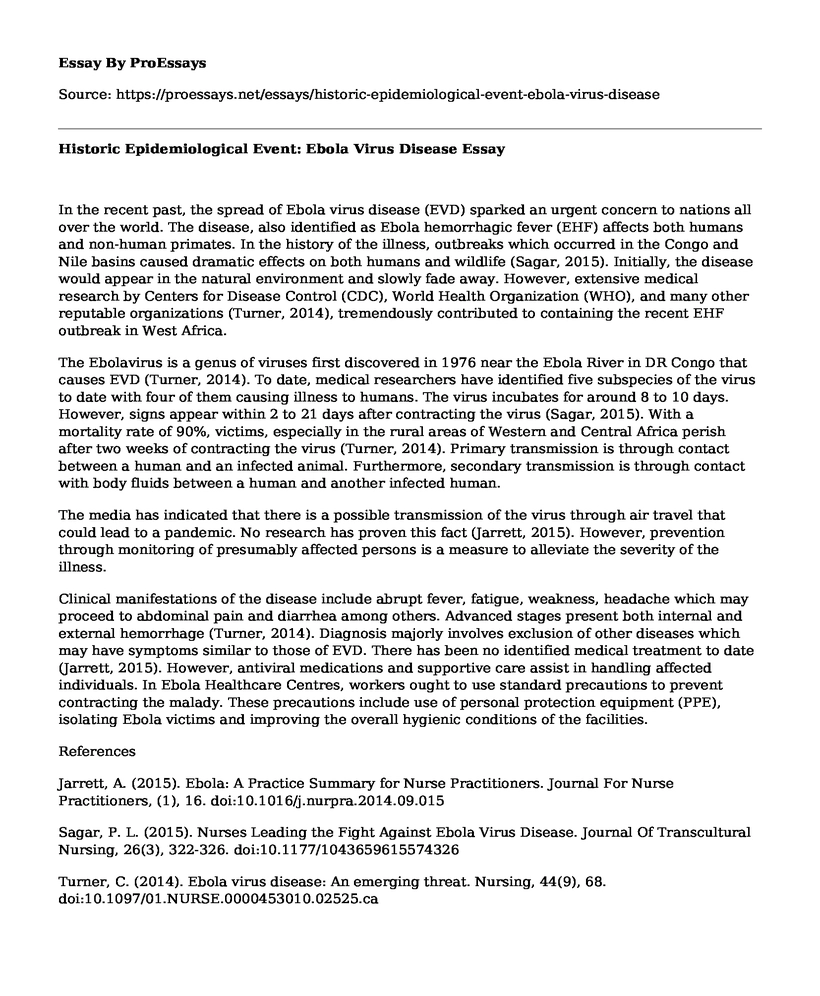In the recent past, the spread of Ebola virus disease (EVD) sparked an urgent concern to nations all over the world. The disease, also identified as Ebola hemorrhagic fever (EHF) affects both humans and non-human primates. In the history of the illness, outbreaks which occurred in the Congo and Nile basins caused dramatic effects on both humans and wildlife (Sagar, 2015). Initially, the disease would appear in the natural environment and slowly fade away. However, extensive medical research by Centers for Disease Control (CDC), World Health Organization (WHO), and many other reputable organizations (Turner, 2014), tremendously contributed to containing the recent EHF outbreak in West Africa.
The Ebolavirus is a genus of viruses first discovered in 1976 near the Ebola River in DR Congo that causes EVD (Turner, 2014). To date, medical researchers have identified five subspecies of the virus to date with four of them causing illness to humans. The virus incubates for around 8 to 10 days. However, signs appear within 2 to 21 days after contracting the virus (Sagar, 2015). With a mortality rate of 90%, victims, especially in the rural areas of Western and Central Africa perish after two weeks of contracting the virus (Turner, 2014). Primary transmission is through contact between a human and an infected animal. Furthermore, secondary transmission is through contact with body fluids between a human and another infected human.
The media has indicated that there is a possible transmission of the virus through air travel that could lead to a pandemic. No research has proven this fact (Jarrett, 2015). However, prevention through monitoring of presumably affected persons is a measure to alleviate the severity of the illness.
Clinical manifestations of the disease include abrupt fever, fatigue, weakness, headache which may proceed to abdominal pain and diarrhea among others. Advanced stages present both internal and external hemorrhage (Turner, 2014). Diagnosis majorly involves exclusion of other diseases which may have symptoms similar to those of EVD. There has been no identified medical treatment to date (Jarrett, 2015). However, antiviral medications and supportive care assist in handling affected individuals. In Ebola Healthcare Centres, workers ought to use standard precautions to prevent contracting the malady. These precautions include use of personal protection equipment (PPE), isolating Ebola victims and improving the overall hygienic conditions of the facilities.
References
Jarrett, A. (2015). Ebola: A Practice Summary for Nurse Practitioners. Journal For Nurse Practitioners, (1), 16. doi:10.1016/j.nurpra.2014.09.015
Sagar, P. L. (2015). Nurses Leading the Fight Against Ebola Virus Disease. Journal Of Transcultural Nursing, 26(3), 322-326. doi:10.1177/1043659615574326
Turner, C. (2014). Ebola virus disease: An emerging threat. Nursing, 44(9), 68. doi:10.1097/01.NURSE.0000453010.02525.ca
Cite this page
Historic Epidemiological Event: Ebola Virus Disease. (2021, Mar 22). Retrieved from https://proessays.net/essays/historic-epidemiological-event-ebola-virus-disease
If you are the original author of this essay and no longer wish to have it published on the ProEssays website, please click below to request its removal:
- Smoking in Public
- Contemporary Ethical Issues: Physician-Assisted Suicide Essay
- Business Negotiation/Deal Making
- Benefits of Medical Marijuana and Its Legality
- Research Paper on Adolescent Obesity
- Bariatric Surgery: Benefits and Drawbacks - Research Paper
- Essay on Blood Test: Check Cell Count, Vitamin B12, Iron, Protein, Retinol-Binding Protein & Albium







